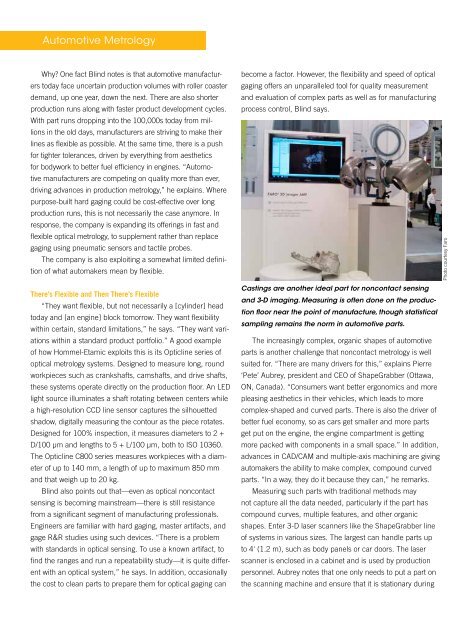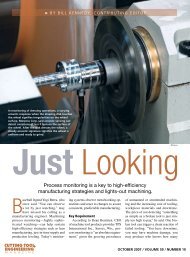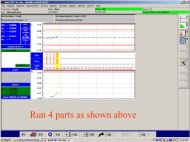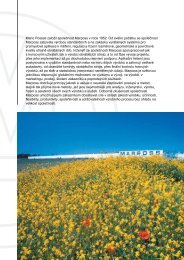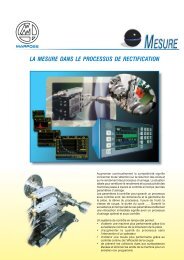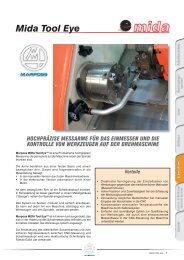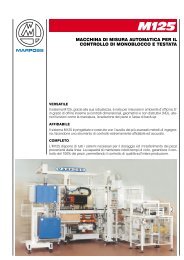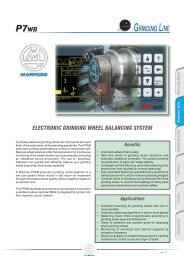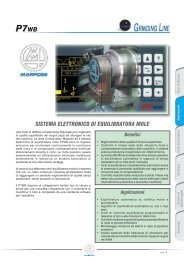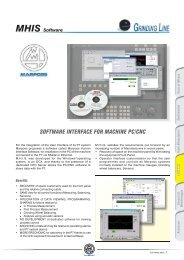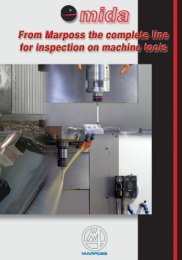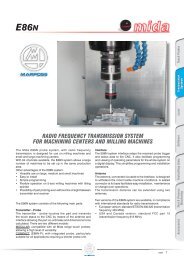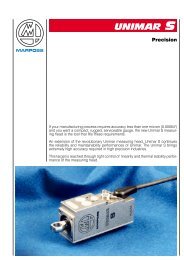Auto Manufacturing Focuses on Vision - Marposs
Auto Manufacturing Focuses on Vision - Marposs
Auto Manufacturing Focuses on Vision - Marposs
Create successful ePaper yourself
Turn your PDF publications into a flip-book with our unique Google optimized e-Paper software.
<str<strong>on</strong>g>Auto</str<strong>on</strong>g>motive Metrology<br />
Why? One fact Blind notes is that automotive manufactur-<br />
ers today face uncertain producti<strong>on</strong> volumes with roller coaster<br />
demand, up <strong>on</strong>e year, down the next. There are also shorter<br />
producti<strong>on</strong> runs al<strong>on</strong>g with faster product development cycles.<br />
With part runs dropping into the 100,000s today from milli<strong>on</strong>s<br />
in the old days, manufacturers are striving to make their<br />
lines as flexible as possible. At the same time, there is a push<br />
for tighter tolerances, driven by everything from aesthetics<br />
for bodywork to better fuel efficiency in engines. “<str<strong>on</strong>g>Auto</str<strong>on</strong>g>motive<br />
manufacturers are competing <strong>on</strong> quality more than ever,<br />
driving advances in producti<strong>on</strong> metrology,” he explains. Where<br />
purpose-built hard gaging could be cost-effective over l<strong>on</strong>g<br />
producti<strong>on</strong> runs, this is not necessarily the case anymore. In<br />
resp<strong>on</strong>se, the company is expanding its offerings in fast and<br />
flexible optical metrology, to supplement rather than replace<br />
gaging using pneumatic sensors and tactile probes.<br />
The company is also exploiting a somewhat limited definiti<strong>on</strong><br />
of what automakers mean by flexible.<br />
There’s Flexible and Then There’s Flexible<br />
“They want flexible, but not necessarily a [cylinder] head<br />
today and [an engine] block tomorrow. They want flexibility<br />
within certain, standard limitati<strong>on</strong>s,” he says. “They want variati<strong>on</strong>s<br />
within a standard product portfolio.” A good example<br />
of how Hommel-Etamic exploits this is its Opticline series of<br />
optical metrology systems. Designed to measure l<strong>on</strong>g, round<br />
workpieces such as crankshafts, camshafts, and drive shafts,<br />
these systems operate directly <strong>on</strong> the producti<strong>on</strong> floor. An LED<br />
light source illuminates a shaft rotating between centers while<br />
a high-resoluti<strong>on</strong> CCD line sensor captures the silhouetted<br />
shadow, digitally measuring the c<strong>on</strong>tour as the piece rotates.<br />
Designed for 100% inspecti<strong>on</strong>, it measures diameters to 2 +<br />
D/100 µm and lengths to 5 + L/100 µm, both to ISO 10360.<br />
The Opticline C800 series measures workpieces with a diameter<br />
of up to 140 mm, a length of up to maximum 850 mm<br />
and that weigh up to 20 kg.<br />
Blind also points out that—even as optical n<strong>on</strong>c<strong>on</strong>tact<br />
sensing is becoming mainstream—there is still resistance<br />
from a significant segment of manufacturing professi<strong>on</strong>als.<br />
Engineers are familiar with hard gaging, master artifacts, and<br />
gage R&R studies using such devices. “There is a problem<br />
with standards in optical sensing. To use a known artifact, to<br />
find the ranges and run a repeatability study—it is quite different<br />
with an optical system,” he says. In additi<strong>on</strong>, occasi<strong>on</strong>ally<br />
the cost to clean parts to prepare them for optical gaging can<br />
become a factor. However, the flexibility and speed of optical<br />
gaging offers an unparalleled tool for quality measurement<br />
and evaluati<strong>on</strong> of complex parts as well as for manufacturing<br />
process c<strong>on</strong>trol, Blind says.<br />
Castings are another ideal part for n<strong>on</strong>c<strong>on</strong>tact sensing<br />
and 3-D imaging. Measuring is often d<strong>on</strong>e <strong>on</strong> the producti<strong>on</strong><br />
floor near the point of manufacture, though statistical<br />
sampling remains the norm in automotive parts.<br />
The increasingly complex, organic shapes of automotive<br />
parts is another challenge that n<strong>on</strong>c<strong>on</strong>tact metrology is well<br />
suited for. “There are many drivers for this,” explains Pierre<br />
‘Pete’ Aubrey, president and CEO of ShapeGrabber (Ottawa,<br />
ON, Canada). “C<strong>on</strong>sumers want better erg<strong>on</strong>omics and more<br />
pleasing aesthetics in their vehicles, which leads to more<br />
complex-shaped and curved parts. There is also the driver of<br />
better fuel ec<strong>on</strong>omy, so as cars get smaller and more parts<br />
get put <strong>on</strong> the engine, the engine compartment is getting<br />
more packed with comp<strong>on</strong>ents in a small space.” In additi<strong>on</strong>,<br />
advances in CAD/CAM and multiple-axis machining are giving<br />
automakers the ability to make complex, compound curved<br />
parts. “In a way, they do it because they can,” he remarks.<br />
Measuring such parts with traditi<strong>on</strong>al methods may<br />
not capture all the data needed, particularly if the part has<br />
compound curves, multiple features, and other organic<br />
shapes. Enter 3-D laser scanners like the ShapeGrabber line<br />
of systems in various sizes. The largest can handle parts up<br />
to 4' (1.2 m), such as body panels or car doors. The laser<br />
scanner is enclosed in a cabinet and is used by producti<strong>on</strong><br />
pers<strong>on</strong>nel. Aubrey notes that <strong>on</strong>e <strong>on</strong>ly needs to put a part <strong>on</strong><br />
the scanning machine and ensure that it is stati<strong>on</strong>ary during<br />
Photo courtesy Faro


